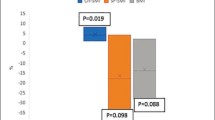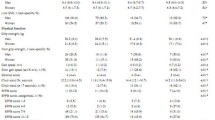Abstract
Summary
This 3-year longitudinal study among older adults showed that declining muscle mass, strength, power, and physical performance are independent contributing factors to increased fear of falling, while declines of muscle mass and physical performance contribute to deterioration of quality of life. Our findings reinforce the importance of preserving muscle health with advancing age.
Introduction
The age-associated loss of skeletal muscle quantity and function are critical determinants of independent physical functioning in later life. Longitudinal studies investigating how decrements in muscle components of sarcopenia impact fear of falling (FoF) and quality of life (QoL) in older adults are lacking.
Methods
Twenty-six healthy older subjects (age, 74.1 ± 3.7; Short Physical Performance Battery (SPPB) score ≥10) and 22 mobility-limited older subjects (age, 77.2 ± 4.4; SPPB score ≤9) underwent evaluations of lower extremity muscle size and composition by computed tomography, strength and power, and physical performance at baseline and after 3-year follow-up. The Falls Efficacy Scale (FES) and Short Form-36 questionnaire (SF-36) were also administered at both timepoints to assess FoF and QoL, respectively.
Results
At 3-year follow-up, muscle cross-sectional area (CSA) (p < 0.013) and power decreased (p < 0.001), while intermuscular fat infiltration increased (p < 0.001). These decrements were accompanied with a longer time to complete 400 m by 22 ± 46 s (p < 0.002). Using linear mixed-effects regression models, declines of muscle CSA, strength and power, and SPPB score were associated with increased FES score (p < 0.05 for each model). Reduced physical component summary score of SF-36 over follow-up was independently associated with decreased SPPB score (p < 0.020), muscle CSA (p < 0.046), and increased 400 m walk time (p < 0.003).
Conclusions
In older adults with and without mobility limitations, declining muscle mass, strength, power, and physical performance contribute independently to increase FoF, while declines of muscle mass and physical performance contribute to deterioration of QoL. These findings provide further rationale for developing interventions to improve aging muscle health.

Similar content being viewed by others
References
Visser M, Goodpaster BH, Kritchevsky SB, Newman AB, Nevitt M, Rubin SM, Simonsick EM, Harris TB (2005) Muscle mass, muscle strength, and muscle fat infiltration as predictors of incident mobility limitations in well-functioning older persons. J Gerontol A Biol Sci Med Sci 60:324–333
Rizzoli R, Reginster JY, Arnal JF et al (2013) Quality of life in sarcopenia and frailty. Calcif Tissue Int 93:101–120
Dam TT, Peters KW, Fragala M et al (2014) An evidence-based comparison of operational criteria for the presence of sarcopenia. J Gerontol A Biol Sci Med Sci 69:584–590
Manini TM, Clark BC (2012) Dynapenia and aging: an update. J Gerontol A Biol Sci Med Sci 67:28–40
Reid KF, Fielding RA (2012) Skeletal muscle power: a critical determinant of physical functioning in older adults. Exerc Sport Sci Rev 40:4–12
Hairi NN, Cumming RG, Naganathan V, Handelsman DJ, Le Couteur DG, Creasey H, Waite LM, Seibel MJ, Sambrook PN (2010) Loss of muscle strength, mass (sarcopenia), and quality (specific force) and its relationship with functional limitation and physical disability: the Concord Health and Ageing in Men Project. J Am Geriatr Soc 58:2055–2062
Go SW, Cha YH, Lee JA, Park HS (2013) Association between sarcopenia, bone density, and health-related quality of life in Korean men. Korean J Fam Med 34:281–288
Kull M, Kallikorm R, Lember M (2012) Impact of a new sarco-osteopenia definition on health-related quality of life in a population-based cohort in Northern Europe. J Clin Densitom 15:32–38
Scheffer AC, Schuurmans MJ, van Dijk N, van der Hooft T, de Rooij SE (2008) Fear of falling: measurement strategy, prevalence, risk factors and consequences among older persons. Age Ageing 37:19–24
Deshpande N, Metter EJ, Bandinelli S, Lauretani F, Windham BG, Ferrucci L (2008) Psychological, physical, and sensory correlates of fear of falling and consequent activity restriction in the elderly: the InCHIANTI study. Am J Phys Med Rehabil 87:354–362
Vellas B, Cayla F, Bocquet H, de Pemille F, Albarede JL (1987) Prospective study of restriction of activity in old people after falls. Age Ageing 16:189–193
Cumming RG, Salkeld G, Thomas M, Szonyi G (2000) Prospective study of the impact of fear of falling on activities of daily living, SF-36 scores, and nursing home admission. J Gerontol A Biol Sci Med Sci 55:M299–M305
Denkinger MD, Lukas A, Nikolaus T, Hauer K (2014) Factors associated with fear of falling and associated activity restriction in community-dwelling older adults: a systematic review. Am J Geriatr Psychiatr 23:72–86
Reid KF, Pasha E, Doros G, Clark DJ, Patten C, Phillips EM, Frontera WR, Fielding RA (2014) Longitudinal decline of lower extremity muscle power in healthy and mobility-limited older adults: influence of muscle mass, strength, composition, neuromuscular activation and single fiber contractile properties. Eur J Appl Physiol 114:29–39
Guillemin F, Martinez L, Calvert M et al (2013) Fear of falling, fracture history, and comorbidities are associated with health-related quality of life among European and US women with osteoporosis in a large international study. Osteoporos Int 24:3001–3010
Chang NT, Chi LY, Yang NP, Chou P (2010) The impact of falls and fear of falling on health-related quality of life in Taiwanese elderly. J Community Health Nurs 27:84–95
Brouwer B, Musselman K, Culham E (2004) Physical function and health status among seniors with and without a fear of falling. Gerontology 50:135–141
Reid KF, Doros G, Clark DJ, Patten C, Carabello RJ, Cloutier GJ, Phillips EM, Krivickas LS, Frontera WR, Fielding RA (2012) Muscle power failure in mobility-limited older adults: preserved single fiber function despite lower whole muscle size, quality and rate of neuromuscular activation. Eur J Appl Physiol 112:2289–2301
Guralnik JM, Simonsick EM, Ferrucci L, Glynn RJ, Berkman LF, Blazer DG, Scherr PA, Wallace RB (1994) A short physical performance battery assessing lower extremity function: association with self-reported disability and prediction of mortality and nursing home admission. J Gerontol 49:M85–M94
Guralnik JM, Ferrucci L, Simonsick EM, Salive ME, Wallace RB (1995) Lower-extremity function in persons over the age of 70 years as a predictor of subsequent disability. N Engl J Med 332:556–561
Guralnik JM, Ferrucci L, Pieper CF, Leveille SG, Markides KS, Ostir GV, Studenski S, Berkman LF, Wallace RB (2000) Lower extremity function and subsequent disability: consistency across studies, predictive models, and value of gait speed alone compared with the short physical performance battery. J Am Geriatr Soc 55:M221–M231
Sayers SP, Guralnik JM, Thombs LA, Fielding RA (2005) Effect of leg muscle contraction velocity on functional performance in older men and women. J Am Geriatr Soc 53:467–471
Bassey EJ, Fiatarone MA, O’Neill EF, Kelly M, Evans WJ, Lipsitz LA (1992) Leg extensor power and functional performance in very old men and women. Clin Sci (Lond) 82:321–327
Callahan D, Phillips E, Carabello R, Frontera WR, Fielding RA (2007) Assessment of lower extremity muscle power in functionally-limited elders. Aging Clin Exp Res 19:194–199
Lustgarten MS, Price LL, Phillips EM, Fielding RA (2013) Serum glycine is associated with regional body fat and insulin resistance in functionally-limited older adults. PLoS One 8:e84034
Ochi M, Tabara Y, Kido T, Uetani E, Ochi N, Igase M, Miki T, Kohara K (2010) Quadriceps sarcopenia and visceral obesity are risk factors for postural instability in the middle-aged to elderly population. Geriatr Gerontol Int 10:233–243
Ware JE Jr, Sherbourne CD (1992) The MOS 36-item short-form health survey (SF-36)I Conceptual framework and item selection. Med Care 30:473–483
McHorney CA, Ware JE Jr, Raczek AE (1993) The MOS 36-Item Short-Form Health Survey (SF-36): II Psychometric and clinical tests of validity in measuring physical and mental health constructs. Med Care 31:247–263
Tinetti ME, Richman D, Powell L (1990) Falls efficacy as a measure of fear of falling. J Gerontol 45:P239–P243
Tinetti ME, Baker DI, McAvay G, Claus EB, Garrett P, Gottschalk M, Koch ML, Trainor K, Horwitz RI (1994) A multifactorial intervention to reduce the risk of falling among elderly people living in the community. N Engl J Med 331:821–827
Radloff LS (1977) The CES-D scale: a self-report depression scale for research in the general population. Appl Psychol Meas 1:385–401
Delbaere K, Close JC, Brodaty H, Sachdev P, Lord SR (2010) Determinants of disparities between perceived and physiological risk of falling among elderly people: cohort study. BMJ 341:c4165
Park JH, Cho H, Shin JH, Kim T, Park SB, Choi BY, Kim MJ (2014) Relationship among fear of falling, physical performance, and physical characteristics of the rural elderly. Am J Phys Med Rehabil 93(5):379–386
Delbaere K, Sturnieks DL, Crombez G, Lord SR (2009) Concern about falls elicits changes in gait parameters in conditions of postural threat in older people. J Gerontol A Biol Sci Med Sci 64:237–242
Rochat S, Bula CJ, Martin E, Seematter-Bagnoud L, Karmaniola A, Aminian K, Piot-Ziegler C, Santos-Eggimann B (2010) What is the relationship between fear of falling and gait in well-functioning older persons aged 65 to 70 years? Arch Phys Med Rehabil 91:879–884
Binda SM, Culham EG, Brouwer B (2003) Balance, muscle strength, and fear of falling in older adults. Exp Aging Res 29:205–219
Oh B, Cho B, Choi HC, Son KY, Park SM, Chun S, Cho SI (2014) The influence of lower-extremity function in elderly individuals’ quality of life (QOL): an analysis of the correlation between SPPB and EQ-5D. Arch Gerontol Geriatr 58:278–282
Groessl EJ, Kaplan RM, Rejeski WJ, Katula JA, King AC, Frierson G, Glynn NW, Hsu FC, Walkup M, Pahor M (2007) Health-related quality of life in older adults at risk for disability. Am J Prev Med 33:214–218
Samuel D, Rowe P, Hood V, Nicol A (2012) The relationships between muscle strength, biomechanical functional moments and health-related quality of life in non-elite older adults. Age Ageing 41:224–230
Sayer AA, Syddall HE, Martin HJ, Dennison EM, Roberts HC, Cooper C (2006) Is grip strength associated with health-related quality of life? Findings from the Hertfordshire cohort study. Age Ageing 35:409–415
Katula JA, Rejeski WJ, Marsh AP (2008) Enhancing quality of life in older adults: a comparison of muscular strength and power training. Health Qual Life Outcomes 6:45
Glintborg D, Nielsen TL, Wraae K, Hougaard D, Gudex C, Brixen K, Andersen M (2014) The relationship between health-related quality of life, obesity and testosterone levels in older men. Age Ageing 43:280–284
Acknowledgments
This work was supported by the National Institute on Aging grant AG18844 and based upon work supported by the US Department of Agriculture (58-1950-0-014), the Boston Claude D. Pepper Older Americans Independence Center (1P30AG031679), and the Boston Rehabilitation Outcomes Center, funded by National Institutes of Health infrastructure grant (1R24HD065688-01A1). Any opinions, findings, conclusion, or recommendations expressed in this publication are those of the author(s) and do not necessarily reflect the view of the US Department of Agriculture.
The funding source had no role in the design and conduct of the study; collection, management, analysis, and interpretation of the data; preparation, review, or approval of the manuscript; and decision to submit the manuscript for publication.
Conflicts of interest
Andrea Trombetti, Kieran F. Reid, Mélany Hars, François R. Herrmann, Evan Pasha, Edward M. Phillips and Roger A. Fielding declare that they have no conflict of interest.
Author information
Authors and Affiliations
Corresponding author
Rights and permissions
About this article
Cite this article
Trombetti, A., Reid, K.F., Hars, M. et al. Age-associated declines in muscle mass, strength, power, and physical performance: impact on fear of falling and quality of life. Osteoporos Int 27, 463–471 (2016). https://doi.org/10.1007/s00198-015-3236-5
Received:
Accepted:
Published:
Issue Date:
DOI: https://doi.org/10.1007/s00198-015-3236-5




